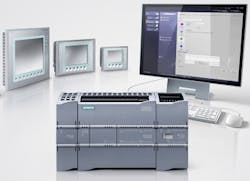New Compact Controller Integrates HMI, Networking
Users benefit from the single programming interface by saving time in engineering development, installation and maintenance. This compact controller class, which includes the new S7-1200 controller, HMI Basic Panels, and the Step 7 Basic software, provides an integrated automation solution suited to the needs of OEMs, integrators and end-users.The S7-1200 has built-in Ethernet, high speed motion control I/O and onboard analog I/O, with HMI panel connectivity providing integrated automation for small control systems. The Simatic Step 7 Basic programming software offers the unique capability of one user program to be maintained instead of multiple programs for controller, HMI and networking configuration, as found in traditional automation systems.Tight integration between small controllers, HMI panels and programming software satisfies market demand for flexible control systems that can perform multiple operations and require minimal changeovers. Raj Batra, vice president, Automation and Motion Division, Siemens Energy & Automation, says, “The S7-1200 and Step 7 Basic engineering software form the first of a new breed of compact controllers that integrate the controller, HMI and networking functionalities with one program, enabling users to focus on developing machine or system designs - their core intellectual property that keeps them competitive.”Controller, HMI, software optionsThe S7-1200 compact controller has a variety of I/O and power supply options with combinations of VAC- or VDC-supplied units or with combinations of DC or Relay I/O. Expansion I/O and specialty modules can be DIN rail or panel mounted, both without an additional base or rack, reducing electrical enclosure space and cost. Expansion modules are available in 8-, 16- and 32-point input, output and combination models supporting DC, Relay and Analog I/O signals. New signal boards available in 4-channel digital or 1-channel analog I/O snap into the front of the S7-1200 controller enabling I/O upgrades without consuming additional enclosure space. This scalable design can accommodate applications from 10 I/O up to a maximum full expansion of 284 I/O, with user software program transparency throughout its range.The S7-1200 also includes an integrated 10/100Mbit Ethernet communications port with PROFINET protocol support for programming, HMI/SCADA connectivity, or PLC-to-PLC networking. Traditional controllers often require a separate add-on module for Ethernet communication which adds more cost and consumes more installation space without providing any additional I/O connections.Simatic Step 7 Basic software with the integrated WinCC Basic for visualization tasks offers the unique capability of a single programming software with a single user program for configuring the S7-1200 and SIMATIC HMI Basic Panels. Users will save valuable engineering time and money with intuitive task-oriented editors designed with a high degree of user-friendliness and efficiency for engineering.For more information on the Simatic S7-1200 Compact Controller, please click here.

